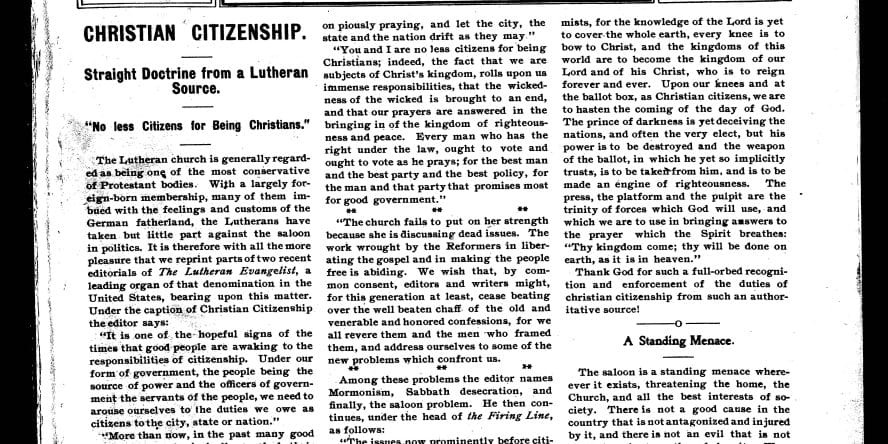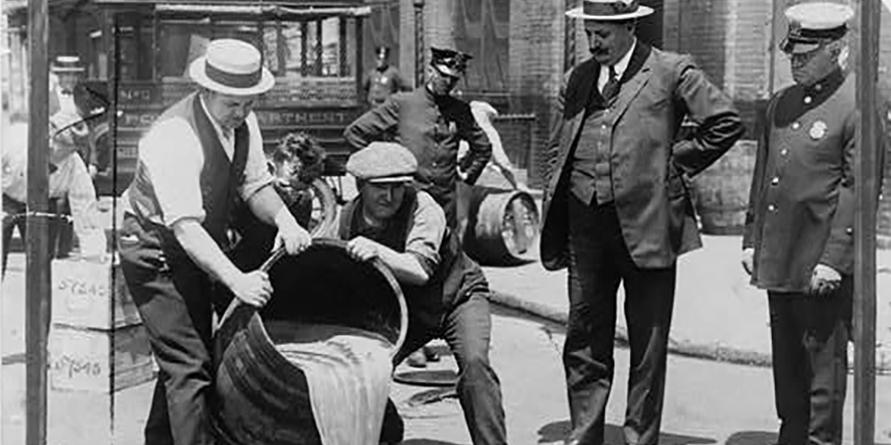Whisky or Whiskey
Below is an excerpt from the Standard Encyclopedia of the Alcohol Problem regarding the production of whiskey.
An alcoholic beverage obtained by distillation. The term is derived from the Gaelic uisge-beatha, later shortened to usquebaugh, and meaning, like the Latin aqua vitae and the French eau devie, "water of life."
Stanford, cited by Dr. B. W. Richardson, says aqua vitae "was used as a drink as early as the year 1260 of our present era," and that the Arabians taught the use of it to the Spaniards, and the Spaniards to the monks of Ireland. In Ireland, he adds, the drink is sometimes called "potheen or poteen," from the poitin, or still, from which the liquor was distilled.
Whisky is obtained from the fermented mash of varieties of grain, the name given it in medicine being Spiritus frumenti ("Spirits of grain"). The classification of the different varieties is based upon the grains used; thus corn whisky, chiefly from corn or maize; rye whiskey, chiefly from rye, etc. Corn whisky, produced mainly in Kentucky, was often called Bourbon, from the county in which it was manufactured. The "New International Encyclopedia" says:
But, while the chief constituent of whisky is alcohol, and a large quantity of factitious liquor is sold under this name, which is simply rectified alcohol, colored and flavored to resemble whisky, yet genuine whisky is very far from being merely a 50 per cent mixture of alcohol and water. The Pharmacopoeia definition is: "An alcoholic liquor obtained by the distillation of the mash of fermented grain (usually a mixture of corn, wheat, and rye), and at least four years old."Whisky is obtained from potatoes also.
The whiskies distilled in different countries have distinctive characteristics as to quality and flavor. Scotch whisky, usually made from barley, is peat-cured and has a smoky flavor; Irish whisky is sweet and has a full bouquet; American whisky has a more pungent flavor and greater body than either Scotch or Irish. The better varieties of British whisky are carefully selected blends.
As whisky is obtained largely from starchy products, such as cereals and potatoes, a preliminary process is required to transform the starch into sugar; the saccharin substance is then fermented, and the resulting product distilled. The diastase from malt, especially barley malt, is the agent usually employed in the process of transforming the starch into sugar, which is called "mashing." In the manufacture of whisky this is accomplished at a lower temperature than in the manufacture of beer. The resulting infusion, called"wort,"is treated with yeast, which induces fermentation and converts the saccharin matter into alcohol. There are two different methods of fermentation, which produce sweet- and sour-mash whiskies. The period of fermentation for sweet-mash whisky is usually 72 hours; for sour-mash, 96 hours. The process of souring the mash frequently prevents the development of unfavorable bacteria. The alcoholic mixture obtained from fermentation, now called the "wash," is ready for the still. This is a copper vessel, provided with a close head terminating in a bent tube which passes, in the form of a spiral called the "worm," through a refrigerating chamber filled with cold water. Heat is applied, the spirit beginning to vaporize at about 176'. The vapor, passing through the worm, is condensed by the cold and drops into a receiver. Redistillation is required to produce strength and purity. Rectification and filtration through bone charcoal or wood are frequently employed. Modern manufacturing apparatus includes complicated pot- and patent-stills, which produce whiskies of different strengths and characteristics.
The process of aging is important, as newly distilled whisky is fiery and unpalatable. This is accomplished by casking the raw whisky and storing in cellars, where atmospheric conditions play an important part in determining the quality and character of the ultimate product. Seasoned oak casks, charred casks, or those impregnated with sherry are most frequently used. The period required is from four to twelve years.
Due to the length of time required before marketing, expense of suitable apparatus, and difficulty of detection, the practises of adulterating and misbranding whisky have been frequent and flagrant, particularly in the United States, where the evil reached such proportions as to become the subject of stringent legislation in the Pure Foods and Drugs Act of 1906. This Act was especially concerned with the transportation as an article of commerce of mislabeled whisky, composed of compounds, imitations, and blends. A lengthy controversy over misbranding, inaugurated by the distillers, centered around a definition of the terms "whisky,' "neutral spirits" and "like substances," as employed in the Act.
In February, 1910, the United States Department of Agriculture, in Food Inspection Decision No. 113, superseding all previous decisions, ruled with regard to the classification and labeling of whiskies:
Under the Food and Drugs Act of June 30, 1906, all unmixed distilled spirits from grain, colored and flavored with harmless color and flavor, in the customary ways, either by the charred barrel process, or by the addition of caramel and harmless flavor, if of potable strength and not less than 80' proof, are entitled to the name whisky without qualification. If the proof be less than 80', i.e., if more water be added, the actual proof must be stated upon the label and this requirement applies as well to blends and compounds of whisky.
Whiskies of the same or different kinds, i.e., straight whisky, rectified whisky, redistilled whisky and neutral spirits whisky or like substances and mixtures of such whiskies, with or without harmless color or flavor used for purposes of coloring and flavoring only, are blends under the law and must be so labeled. In labeling blends the Act requires two things to be stated upon the label to bring the blended product within the exception provided by the statute: First, the blend must be labeled, branded or tagged so as to plainly indicate that it is a blend, in other words that it is composed of two or more like substances, which in the case of whisky must each be of itself a whisky, and Second, the word "blend" must be plainly stated upon the package in which the mixture is offered for sale. A mixture of whiskies, therefore, with or without harmless coloring or flavoring, used for coloring and flavoring only, is correctly labeled "Kerwan Whisky. A Blend of Whiskies.
With reference to mixtures of whisky with potable alcoholic distillates from sources other than grain, such as cane, fruit, or vegetables, the decision states that they are required to be labeled as compounds, as, for example, "Kerwan Whisky. A compound of whisky and cane distillate." When essence or oil is added to one variety of whisky with intent to simulate another, the imitation must be indicated, as for example, if rye essence were added to a highly rectified distillate of corn, the mixture would not be misbranded if labeled "Whisky-Imitation Rye."
Appeal was made from this interpretation, but in Decision No. 118, issued in May, 1910, the Department declined to modify its position. The Decision read:
At the instance of certain parties in interest we have considered the suggestion for a modification of the rules embodied in Food Inspection Decision No. 113. The suggestion was that mixtures of whiskey with a potable alcohol distillate from sources other than grain, such as cane, fruit, or vegetables, are not misbranded if labeled "a blend of whiskey and neutral spirit." After exhaustive consideration we have concluded that such a change would be in conflict with the controlling reason of the rule itself. It has also been suggested that the term "blend" might be employed under the circumstances given if the neutral spirit disclosed its origin by the designation "neutral molasses spirit," or other like terms. While a modification in that form might protect the public against deception or misunderstanding, we are nevertheless of the opinion that such a modification would still be in conflict with the fundamental principle adopted in the President's opinion and in Food Inspection Decision No. 113. In our opinion such a combination, if it is to be designated according to the terms of the law, would be a compound, and not a blend, and if either term is to be employed, the former is the only one that is permissible.
Our conclusion accordingly is that we must decline to modify the decision heretofore adopted in this respect.
The opinion of the President (Taft) referred to, held:
After an examination of all the evidence it seems to me overwhelmingly established that for a hundred years the term "whisky" in the trade and among the customers has included all potable liquor distilled from grain; that the straight whisky is, as compared with the whisky made by rectification or redistillation and flavoring and coloring matter, a subsequent improvement, and that therefore it is a perversion of the pure-food act to attempt now to limit the meaning of the term "whisky" to that which modern manufacture and taste have made the most desirable variety.
It is undoubtedly true that the liquor trade has been disgracefully full of frauds upon the public by false labels, but these frauds did not consist in palming off something which was not whisky as whisky, but in palming off one kind of whisky as another and better kind of whisky. 'Whisky made of rectified redistilled or neutral spirits and given a color and flavor by burnt sugar, made in a few days, was often branded as Bourbon or rye straight whisky. The way to remedy this evil Is not to attempt to change the meaning and scope of the term "whisky," accorded to it for one hundred years, and narrow it to include only straight whisky; and there is nothing in the pure-food law that warrants the inference of such an intention by Congress.
In the case of an established product sold under a trade name, but composed of a mixture of two separate and distinct distillates of grain, such as "Canadian Club whisky," upon which the Department of Agriculture asked the opinion of Attorney-general Wickersham, the latter, in a Decision of Oct. 19, 1010, after a resume of the case, declared:
. . . it appears to me clear that the name "Canadian Club whisky" is a distinctive name, so arbitrary and so fanciful as to clearly distinguish it from all other kinds of whisky or other things, and a name which, by common use, has come to mean a substance clearly distinguishable by the public from anything else... In my opinion, therefore, it is not necessary that the label under which "Canadian Club whisky" is sold shall state that it is "a blend of whiskies."
The accompanying Tables I and II give the production of whisky in the United States in gallons, according to the reports of the Internal Revenue Department, from 1878 to 1920. Prior to July 1, 1877, no returns were made for spirits other than fruit brandy. A new classification of spirits from 1909 and 1910 combined the statistics on Bourbon and Rye whiskies.
---
Entry from the Standard Encyclopedia of the Alcohol Problem
About the League
Museum Hours
Monday-Saturday: 9am-6pm
Closed on Saturday: 1-2pm
Closed on Sunday








